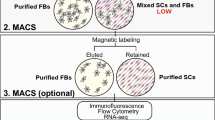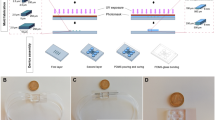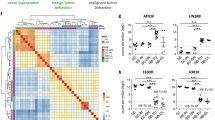Abstract
We describe a simple, rapid and highly selective protocol for the primary culture of Schwann cells in vitro from freshly dissociated adult rat nerve. The protocol is based on a selective culture medium comprising both mitogens (forskolin and optionally N2 supplement plus bovine pituitary extract), to stimulate growth of Schwann cells, plus an inhibitory substrate to simultaneously restrict fibroblast overgrowth (D-valine), contained in DMEM. This protocol differs from other available methods in that it uses the preferential capacity of Schwann cells to metabolize D-valine because of the difference in expression of a D-amino acid oxidase (DAAO) enzyme between Schwann cells and fibroblasts plus the presence of a selective mitogen to stimulate growth of Schwann cells. This permits derivation of highly pure Schwann cells directly from fresh adult nerve. Average Schwann cell purities of 97% can be achieved after 19 d without pre-degeneration, purification or antimitotic steps.
This is a preview of subscription content, access via your institution
Access options
Subscribe to this journal
Receive 12 print issues and online access
$259.00 per year
only $21.58 per issue
Buy this article
- Purchase on Springer Link
- Instant access to full article PDF
Prices may be subject to local taxes which are calculated during checkout


Similar content being viewed by others
References
Bell, J.H. & Haycock, J.W. Next generation nerve guides: materials, fabrication, growth factors and cell delivery. Tissue Eng. Part B Rev. 18, 116–128 (2012).
Brockes, J.P., Fields, K.L. & Raff, M.C. Studies on cultured rat schwann-cells. 1. establishment of purified populations from cultures of peripheral-nerve. Brain Res. 165, 105–118 (1979).
Needham, L.K., Tennekoon, G.I. & Mckhann, G.M. Selective growth of rat schwann-cells in neuron-free and serum-free primary culture. J. Neurosci. 7, 1–9 (1987).
Morrissey, T.K., Kleitman, N. & Bunge, R.P. Isolation and functional-characterization of schwann-cells derived from adult peripheral-nerve. J. Neurosci. 11, 2433–2442 (1991).
Vroemen, M. & Weidner, N. Purification of Schwann cells by selection of p75 low affinity nerve growth factor receptor expressing cells from adult peripheral nerve. J. Neurosci. Methods 124, 135–143 (2003).
Komiyama, T. et al. A novel technique to isolate adult Schwann cells for an artificial nerve conduit. J. Neurosci. Methods 122, 195–200 (2003).
Mauritz, C., Grothe, C. & Haastert, K. Comparative study of cell culture and purification methods to obtain highly enriched cultures of proliferating adult rat Schwann cells. J. Neurosci. Res. 77, 453–461 (2004).
Haastert, K., Mauritz, C., Chaturvedi, S. & Grothe, C. Human and rat adult Schwann cell cultures: fast and efficient enrichment and highly effective non-viral transfection protocol. Nat. Protoc. 2, 99–104 (2007).
Bunge, M.B., Wood, P.M., Tynan, L.B., Bates, M.L. & Sanes, J.R. Perineurium originates from fibroblasts—demonstration in vitro with a retroviral marker. Science 243, 229–231 (1989).
Trachtenberg, J.T. & Thompson, W.J. Schwann cell apoptosis at developing neuromuscular junctions is regulated by glial growth factor. Nature 379, 174–177 (1996).
Haastert, K., Seef, P., Stein, V.M., Tipold, A. & Grothe, C. A new cell culture protocol for enrichment and genetic modification of adult canine Schwann cells suitable for peripheral nerve tissue engineering. Res. Vet. Sci. 87, 140–142 (2009).
Jirsova, K., Sodaar, P., Mandys, V. & Bar, P.R. Cold jet: a method to obtain pure Schwann cell cultures without the need for cytotoxic, apoptosis inducing drug treatment. J. Neurosci. Methods 78, 133–137 (1997).
Teare, K.A., Pearson, R.G., Shakesheff, K.M. & Haycock, J.W. Alpha-MSH inhibits inflammatory signalling in Schwann cells. Neuroreport. 15, 493–498 (2004).
Gilbert, S.F. & Migeon, B.R. D-valine as a selective agent for normal human and rodent epithelial-cells in culture. Cell 5, 11–17 (1975).
Hongpaisan, J. Inhibition of proliferation of contaminating fibroblasts by D-valine in cultures of smooth muscle cells from human myometrium. Cell Biol. Int. 24, 1–7 (2000).
Armati, P.J. & Bonner, J. A technique for promoting schwann-cell growth from fresh and frozen biopsy nerve utilizing D-valine medium. In Vitro Cell. Dev. Biol. 26, 1116–1118 (1990).
Armati, P.J., Constable, A.L. & Llewellyn, F. A new medium for in vitro peripheral nervous-tissue myelination without the use of antimitotics. J. Neurosci. Methods 33, 149–155 (1990).
Fregien, N.L., White, L.A., Bunge, M.B. & Wood, P.M. Forskolin increases neuregulin receptors in human Schwann cells without increasing receptor mRNA. Glia 49, 24–35 (2005).
Goodearl, A.D.J. et al. Purification of multiple forms of glial growth factor. J. Biol. Chem. 268, 18095–18102 (1993).
Koroleva, A. et al. Two-photon polymerization-generated and micromolding-replicated 3D scaffolds for peripheral neural tissue engineering applications. Biofabrication 4, 025005 (2012).
Daud, M.F.B., Pawar, K.C., Claeyssens, F., Ryan, A.J. & Haycock, J.W. An aligned 3D neuronal-glial co-culture model for peripheral nerve studies. Biomaterials 33, 5901–5913 (2012).
Acknowledgements
We acknowledge a Royal Thai Government Scholarship (Higher Educational Strategic Scholarships for Frontier Research Network, CHE-PhD SFR) for funding R.K. to undertake her PhD at the University of Sheffield, UK and E.H. Kemp (University of Sheffield, UK) for assistance with the RT-PCR experiments.
Author information
Authors and Affiliations
Contributions
J.W.H., A.M.S. and R.K. conceived the idea. J.W.H., A.M.S. and R.K. designed the experiments. R.K. performed the experiments, and R.K. and J.W.H. analyzed the data. R.K. and J.W.H. wrote the paper.
Corresponding author
Ethics declarations
Competing interests
The authors declare no competing financial interests.
Supplementary information
Supplementary Methods
Isolation and identification of fibroblasts from adult rat sciatic nerve Culture of Schwann cells and fibroblasts for D-amino acid oxidase (DAAO) or growth analysis RT-PCR for D-amino acid oxidase Western blotting of cell lysate for D-amino acid oxidase Schwann cell culture under different medium conditions (PDF 110 kb)
Supplementary Results
Identification of fibroblast cultures Growth inhibition of nerve fibroblasts cultured in Schwann cell culture medium Selective role of mitogenic factors (PDF 80 kb)
Supplementary Figure 1
Identification of epineurium-derived fibroblast cultures maintained in DMEM. (a-c) Immunocytochemistry for Thy-1 and (d-f) Schwann cell protein detection. Positive staining of Thy-1 was detected in nerve fibroblast cultures (a) whereas negative staining of isotype control indicated specificity of Thy-1 antibodies (b). Negative staining for Thy-1 in Schwann cell cultures (c). Negative staining for S100β (d), p75NGFR (e) and GFAP (f) in nerve fibroblast cultures. Scale bar, 100 μm. (PDF 972 kb)
Supplementary Figure 2
Phase contrast microscopy of Schwann cells and fibroblasts and DAAO expression analysis. (a-i) Fibroblast cultures in basal DMEM medium (a, d, g) or Schwann cell culture medium (b, e, h) were compared with Schwann cell cultures (c, f, i) at days 3, 9 and 18. Fibroblasts in DMEM and Schwann cells actively divided whereas fibroblasts exhibited limited growth when cultured in Schwann cell culture medium. At day 18, Schwann cells and fibroblasts in DMEM approached over confluence whereas fibroblasts in Schwann cell culture medium had a low cell density. (j) RT-PCR and densitometry of DAAO as a ratio of alpha-actin (loading control). Genomic DNA was used as a positive control while reactions without reverse transcriptase are a negative control, indicating no genomic DNA contamination. (k) Western blotting plus densitometry of DAAO as a ratio of GAPDH (loading control). Kidney lysate was used as a positive control. Vertical gap in (k) indicates a discontinuing lane, but on the same blotting membrane. Results shown are from one experiment, representing the consistent results from two (RT-PCR) and three (western blot) independent experiments. Scale bar, 100 μm. Abbreviation: F-DMEM or F-SCM, fibroblasts cultured in DMEM or Schwann cell culture medium, respectively; SC-SCM, Schwann cells cultured in Schwann cell culture medium. *, non-specific product. (PDF 589 kb)
Supplementary Figure 3
Schwann cells cultured in DMEM-D valine with or without mitogenic factors (a-f) Cultures stained for S100β. Schwann cells stain positive for S100β and fibroblasts stain negative. Nuclei indicated by DAPI staining. Immunostaining of Schwann cells cultured in complete medium (DMEM-D valine supplemented with all mitogenic factors) (a). Each factor was withdrawn from complete medium: in the absence of forskolin (b); bovine pituitary extract (c) or N2 supplement (d). Schwann cells cultured in DMEM-D valine with forskolin alone (e) or DMEM-D valine alone (f). (g-h) Purity and density of Schwann cells. Purity (g) and cell density (h) based on S100β immunostaining. Data expressed as mean ± SEM (n = 3 rats). *, # P < 0.05; **, ## P < 0.01; ***, ### P < 0.001. * versus DMEM-D valine alone and # versus complete medium in the absence of forskolin by a two-sample unpaired Student's t-test. Scale bar, 100 μm. Animals were sacrificed by a schedule 1 method according to the regulation of the Animals (Scientific Procedures) Act 1986), University of Sheffield, U.K. (Appropriate institutional regulatory board approval must be obtained). (PDF 1884 kb)
Rights and permissions
About this article
Cite this article
Kaewkhaw, R., Scutt, A. & Haycock, J. Integrated culture and purification of rat Schwann cells from freshly isolated adult tissue. Nat Protoc 7, 1996–2004 (2012). https://doi.org/10.1038/nprot.2012.118
Published:
Issue Date:
DOI: https://doi.org/10.1038/nprot.2012.118
This article is cited by
-
Molecular and Regenerative Characterization of Repair and Non-repair Schwann Cells
Cellular and Molecular Neurobiology (2023)
-
Mature but not developing Schwann cells promote axon regeneration after peripheral nerve injury
npj Regenerative Medicine (2022)
-
Augmenting Peripheral Nerve Regeneration with Adipose-Derived Stem Cells
Stem Cell Reviews and Reports (2022)
-
Machine intelligence for nerve conduit design and production
Journal of Biological Engineering (2020)
-
The natural plant flavonoid apigenin is a strong antioxidant that effectively delays peripheral neurodegenerative processes
Anatomical Science International (2019)
Comments
By submitting a comment you agree to abide by our Terms and Community Guidelines. If you find something abusive or that does not comply with our terms or guidelines please flag it as inappropriate.



